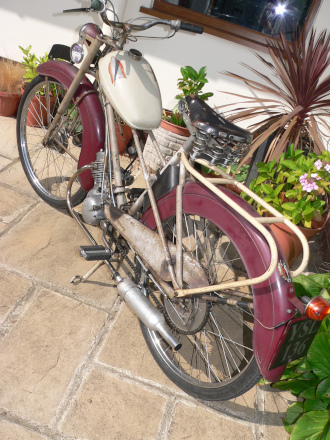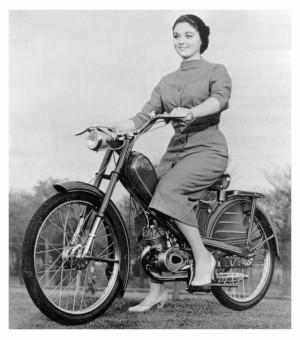Introduction
Iceni CAM Magazine
This is the home of the Iceni CAM Magazine—a
free e-magazine about Cyclemotors, Autocycles, Mopeds … and
more. It was launched on 15 April 2007 and the most recent ten issues
can be downloaded here. All the articles from all the previous magazines are on
this website. For non-computerised folks, printed copies are
available at £1.50 per edition; we can accommodate mail order too at £3.02
for single edition or £12.20 for a year’s subscription.
So what’s it about?
It’s an e-magazine all about cyclemotors, autocycles and mopeds that
carries road test & feature articles, rally reports, free adverts and other
assorted information. Although we are an independent production, we
have strong ties to the EACC and also to the New
Zealand Cyclaid Register.
We are based in East Anglia, but are by no means limited to that
area. Much that appears in the magazine is of universal appeal.
We welcome contributions, wherever they are from, and are also happy to
help to publicise any events for cyclemotors, autocycles and mopeds.
When’s it published?
We publish four times a year at the beginning of January, April, July,
and October. Iceni CAM is purely an enthusiast production, and
all produced on a tiny budget. The free downloadable version will be
posted on this website on the same day as the printed version goes on
sale.
All the issues of CAM Magazine that we’ve produced have been very well
received. Thank you all for your comments; they are much
appreciated. Several of you have also made donations, which has
helped enormously in keeping Iceni CAM going.
What’s in it?
The October 2025 edition is available now on our Downloads Page.
The original Lost World article on
the Mercury Mercette back in April 2003 (for another publication before
IceniCAM) is something that we never thought we’d be covering again, but
yes, the Mercury engine blew up big time in 2010.

But 15 years on there’s been some essential evolution taken place for
the survival of the species … Actually the Super Mercette
project started before the engine exploded, but this re-engineered motor
was initially planned for another second Mercette because the original
Mercury was still working at the time. The new Super 61cc Dunkley
Whippet motor was stripped, the kick-start ratchet removed, the boss cut
out of the right-hand crankcase, an alloy plate welded in and retextured
with an engraving tool so you’d never know!
With the engine rebuilt, it was mounted on a show display stand while
the project was mothballed, awaiting time to work on the second Mercette
frame.
The maths was completed on the 10% gearing-up change, the 11-tooth
sprocket was cut and bronze welded to the clutch basket boss after the
first motor expired, but then the whole project was superseded by other
needs.
It only got picked up again in early 2025 after stripping down the first
Mercette motor and finding it was not recoverable with the condition of the
few parts available, at which point it became an obviously easier solution
toward completion … to resume the ‘Super’ project.
The clutch basket with its 11-tooth sprocket needed a phosphor bronze
bush machining to complete that assembly; a mag-set needed building and
timing, a carburettor sorting out, installation and first running.
The slipping Whippet clutch was obviously not up to the task, so
necessitated making a new clutch to handle the load, then with a few cycle
improvements: the Super Mercette is in business. The bike was insured
and back on the road in early July, then there was a period of brief road
tests, debugging and the official road test. Sat-nav paced at 42mph
and what has to be the fastest ever Mercette is back on the EACC rally
circuit.
What will become of the second Mercette now the Whippet 60 engine is in
the first Mercette? Well there’s an option to try overhauling the
second Mercette’s original 46.6cc engine, or what might we do with the
spare Dunkley 65 engine that’s in the stores? 64cc, 2.6bhp, and even
higher compression ratio? Dunkley claimed 45mph out of their Whippet
Sports, but with the 11-tooth higher gearing conversion … evolution
may only just be starting another new phase for the Ultimate Super
Mercette.
The article was sponsored by Les Gobbett, Lough, Lincolnshire.
We’ve now run out of sponsorship donations, so there are openings to
sponsor articles for our next edition in January 2026. Any modest
donations are gratefully received to keep IceniCAM on-line.
Leila Williams

For its publicity pictures in 1955, Phillips got Leila Williams to pose
with the Earls Court Show Gadabout. In 1957, she would win the title
of ‘Miss Great Britain’ but she is probably most remembered for being one
of the original presenters of Blue Peter, working
on the programme from 1958 to 1962.
The The first Gadabout moped was shown at
Earls Court Motor Cycle Show on 12 November 1955, but the history of
Phillips stretched a long way back before then, and we do like a bit of
interesting history! The P39 was listed from the Earls Court Show,
for sale in the 1956 season, but just a year later the largely German model
had evolved to become a machine of different domestically-produced
parts.
The workshops acquired this really early P39 among a job lot of mopeds
from Bristol in 2001. The bike was initially rebuilt and registered
in 2003 for road use, but the mag flywheel pin sheared in the crank,
causing the timing to slip (a common fault with Rex motors), so it ended up
consigned to a dark and forgotten corner in disgrace. 22 years
later the Phillips surfaced again, scheduled for an article. It was
fitted with a replacement crank, new piston rings, a 13-tooth gear-up
sprocket, a couple of replacement cables, & a new capacitor in the mag-set;
the ignition was re-timed, the cosmetics tidied up, and within just four
days we’re ready to go again!
Another Phillips feature, so how many Phillips motorised models have we
covered now? P36X Motorised Cycle, all three Pandas and even the
second version of the Mk 3 Panda, P39, P45, P50, Mk 4 PM2
Gadabouts, two of the three New Zealand ‘Springer’ Gadabout models, and
even the New Zealand Traveller (a Phillips branded version of the
RM8). We make that 12 Phillips models so far! Who knew there
were so many? Technically maybe we could try to cover a sprung-fork
P36X Motorised Cycle because we only did the earlier rigid-fork version,
and we haven’t done any of the Phillips Cyclemaster models yet, and maybe
at a push, the New Zealand Super-50 (a Phillips branded cross of the white
& fire red RM12 and the RM11 Super Tourist but fitted with Wrights S.65/3
tension-sprung single saddle and maybe no rear carrier). No worries,
we don’t think any other publications are going to be catching us up any
time soon…
‘The First Gadabout’ was sponsored by Garth Jeffrey, EACC Regalia
Officer but we currently have no sponsorship for the No.2 article in the
next edition. If you may care to sponsor an article on a ‘rare and
unusually early sports moped’, then please send in a small donation.
This feature started long before IceniCAM,
and back in 2004 when we picked up the ViVi at Utrecht
Bromfietsbeurs. In Ben Teuben’s van, we took the ViVi to Derrick
Roest at Alphen de Ryn, where we got the bike running so it could be ridden
on and off the boat back to England. Having gone over on a foot
passenger ticket wasn’t going to be an issue coming back from the
Netherlands, since the Dutch classed a moped as a bicycle, and bicycles
travelled free; but if you were travelling the other way from the UK to the
Netherlands, a moped would be classed as a motor cycle and charged for the
crossing. Once in the UK the registration was sorted out, then the
bike just went into deep storage, and 19 years later, in an impulsive
moment, it was decided the time had come, and ViVi was dragged out for its
moment of fame.

Back from the Netherlands: the ViVi in 2004
Considering the bike was ridden back from the Netherlands, it seemed as
if it took a disproportionate amount of work to sort the bike out
functionally and cosmetically in time for the article. It was a close
call for the road test, because a persisting misfire was eventually traced
to a defective ignition capacitor that had already been replaced!
Only in the last week before the editorial deadline did the ViVi engine run
cleanly, and then it went very well.
It’s nice to experience such a good gearshift on a moped with the
Victoria engine. The ball-bearing selection system dispenses with the
usual splined shaft and splined bore on the gears with engagement dogs on
the gears and selectors being the source of all the grinding and crunching
when you try to shift gear. The ball selection system uses bearings
pushed out and in by a sliding shaft to engage and disengage the gears,
allowing you shift silently and smoothly at all times. It was a
system used by Zündapp, Casal, and Victoria; it wasn’t used by Puch, NSU,
Villiers, Sachs, etc.
One of the features that didn’t get a tick of approval was carburettor
access through the small inspection cover on the left-hand side. On
the ViVi it’s difficult, though it can be done, and it’s not quite as bad
as carb access on the Victoria Vicky IV—but it’s puzzling why they made it
so awkward to maintain a standard service item.
Some folks may not be familiar with the Dot brand of Manchester because
it was mainly focused on competition trials motor cycles, and didn’t
produce much in the way of road models, while the Viberti Company of Turin
was probably a total unknown to most people. The Victoria company
since 1886 may be a more familiar name in Germany, but the mopeds were only
imported from January 1956 until 1964 and were relatively expensive in the
UK, so probably not sold in big numbers in comparison with the numbers of
other cheaper makes available. The arrival of ViVi mopeds in Britain
made something of a multi-national story, but sadly we’re unable to
identify how many ViVis were sold in the UK. Probably not very many,
since they rarely seem to turn up in any form, and we may presume they
might have mostly been sold locally. Dot’s own registered dealer
network was maybe more focused on the competition trials bikes that the
company primarily produced, rather than selling its imported mopeds.
Dot ‘makes’ a moped ended with the news that ‘Dot
Motorcycles returned with a brand revival making new motorcycles from
2021’ … but most importantly, we’d like to know when Dot is going to
‘make’ another moped?
The article was sponsored by Derek Langdon from Nottingham. Our
third feature for the next edition currently has no sponsorship, and a
small donation to IceniCAM could put your name or message on it…
What’s Next?
The next magazine is scheduled for publication at the beginning of
January 2026.
Next Main Feature: A spectacular racing 50 from the 1960s, but
this machine looks as if it was designed to be piloted by a 7-stone
contortionist, so can we even ride it?
Next First Support: A rare and unusually early sports moped that
very probably no one has ever heard of. We could say it involves a
certain Leopoldo Rinaldi, but he sounds like some Italian footballer, so
you’re likely going to be none the wiser for that snippet either … just
have to wait and see; it’s ‘A Family Business’.
Next Second Support: Seriously, not seriously, can you really
improve a Motobécane X1? And we have to ask the question: is it worth
it?
What else?
Well, there’s this Website … we’ve put a lot of useful information
here, and we’re alwas adding to it. We have a directory of useful people to know. Information on
local events and, after each run, we put photos of the event on this website. There’s
also a market place where you can buy and sell
mopeds, autocycles, cyclemotors and other related items

As each edition of the magazine is published, we add to our collection
of articles. From Edition 3 of the
magazine, we introduced another evolution. Previously, features in
the articles section had reflected what
appeared in the magazine, but you may now discover a bit of extra content
has crept into some items as they’ve transferred to the website—you might
call it ‘The Directors Cut’. The problem with printed magazines is
editing everything to fit page sizes and space, and there can sometimes be
bits you’d like to include, but they have to be left out to fit the
available space. The web articles don’t need to be constrained by the
same limitations so, although the text will remain the same, the ‘Directors
Cut’ graphic in the header indicates the item carries extra pictures and
bits that didn’t make it to the magazine.
We also have an Information Service—if you want
to know more about your moped, we can help.
What we do
Iceni CAM Magazine is committed to celebrating
all that’s good about the Cyclemotor, Moped and Autocycle scene;
researching toward the advancement of the pool of knowledge about
cyclemotors, autocycles, old mopeds, and other oddities; and the
publication of original material. We are a declared non-profit making
production, though we still need to fund everything somehow to keep the
show on the road.
The magazine is free on line, and the nominal price of supplying hard
copies to non-computerised folks is pitched only to cover printing and
postage. All advertising is free since we believe that the few people left out there providing parts & service for
these obsolete machines do so as a hobby and an interest. This
involves far more effort than reward, and they should be appreciated for
the assistance they provide. Our Information
Service is there to help anyone needing manuals to help with
restoration of a machine. We make a small charge for this but, again,
we have set our prices so the just cover postage and material costs.
However, we are trying to make this free too! We are setting up an
on-line library where you can download
manuals at no charge.
Overheads involve operation of the website, and particularly the
generation of features. Articles like Last Flight of the Eagle can cost as little as £20 to
complete, while others have cost up to £150 to generate, eg: Top Cat on
the Leopard Bobby. With these overheads, you may be wondering how we
get the money to keep it all going. So do we! But, somehow, it
works, helped by a number of generous people who have sponsored articles or
made donations to keep the show on the
road.
How long does it take to research, produce, and get these feature
articles to press? Well, up to two years of preparatory research in
some cases, where little is known about the machine or its makers, and
where nothing has been published before. Then, collating all the
information and interviews, drafting and re-drafting the text, travel and
photoshoots typically account for up to 40 to 50 hours to deliver the
package to editing.
There are many examples where these articles have become the definitive
reference material for previously unpublished machines like:
Ambassador Moped,
Dunkley Whippet & Popular,
Elswick
Hopper Lynx,
Leopard Bobby,
Mercury Mercette & Hermes,
Ostler Mini-Auto,
Raleigh
Ireland Super,
Stella
Minibike,
…and many others.
We’re committed to continuing to produce these articles, because we
believe it needs to be done, and we’ve got a proven track record for
achieving it. Nobody else has done it in 50 odd years, so if we don’t
do it—who will?
To whet your appetite for what’s ahead, here’s an updated
list of machines with developing articles for future features:
Ariel Pixie;
Beretta–Mosquito;
Capriolo 75 Turismo Veloce;
Cyc-Auto (Wallington Butt) & Cyc-Auto (Villiers);
Dunkley S65 & Whippet Super Sports;
Elswick–Hopper VAP MIRA test prototype;
Gilera RS50;
Guazzoni;
Hercules Her-cu-motor;
Honda Gyro Canopy, Model A, CD50, & SS50;
James Comet 1F;
Leri Supersport;
MV Agusta Liberty;
Norman Nippy Mark 3;
Powell Joybike;
Rabeneick Binetta;
Simson SR2E;
Solifer Speed;
Sun Autocycle & Motorette;
Vincent Firefly;
The working list changes all the time as articles are completed and
published, and further new machines become added—so as you see, there’s
certainly no shortage of material.
Readers have probably noticed a number of the articles collecting
sponsorship credits, and we’re very grateful for the donations people have
made toward IceniCAM, which certainly assures we’re going forward into
another year. We don’t need a lot of money since IceniCAM is a
declared non-profit making organisation, and operates on a shoestring (and
we’d like to keep it that way)—run by enthusiasts, for enthusiasts.
It’s easy to sponsor an article by either picking a machine from the
forward list, and we’ll attach your credit to it, or simply making a
donation. There is no fixed amount, it’s entirely up to you, and
however large or small, we’re grateful for any contribution to keep the
show on the road.
If a vehicle you’re interested in seeing an article about isn’t in the
list, then let us know and we’ll see about trying to add it in the
programme, but we do need access to examples—perhaps you have a machine
you’d like to offer for a feature?
See the Contact Page for how to: Sponsor an article–Enter a free advert–Submit an article yourself–Write a letter to us–Propose a machine for feature–Offer your machine for test feature …
News
Updated DVLA policies
20 August 2025
DVLA has announced updated policies to modernise the process for
notifying DVLA when a vehicle has been repaired, restored, and
modified. Like-for-like repairs and restorations will no longer need
to be reported to DVLA, and more modified vehicles—including electric
vehicle (EV) conversions—will be able to retain their original
identities. Changes will take effect from Tuesday 26 August 2025.
The new guidance reflects modern restoration methods and simplifies the
registration process, helping classic car owners keep their vehicles on the
road while ensuring safety and accurate records. These changes follow
an extensive call for evidence, which received more than 1,350 responses
from classic car owners, motoring clubs and the historic vehicle
sector. In response, DVLA is replacing its existing policies on
rebuilt and radically altered vehicles with two new sets of guidance that
will apply to all vehicles, regardless of age.
Key changes include:
like-for-like repairs and restorations will no longer
require notification to DVLA, providing the vehicle’s appearance is the
same as when it was originally manufactured and there are no changes to the
log book (V5C)
vehicles that have been subject to significant structural
modifications will be able to keep their original Vehicle Identification
Number (VIN) and registration number, but the registered keeper must notify
DVLA of the changes.
vehicles that have been converted to electric will also be
able to retain their original identity, but the registered keeper must
notify DVLA of the changes.
On Tuesday 26 August 2025, DVLA will replace its existing policies on
rebuilt and radically altered vehicles with two new sets of guidance:
Repaired and restored vehicles
There will be no requirement to notify DVLA where a vehicle has been
repaired or restored back to its original working standard, providing:
worn-out components or body panels are replaced on a like
for like basis, the appearance of the vehicle is the same as when it was
originally manufactured, Vehicle log book (V5C) details are not
affected.
Modified vehicles
Vehicles that have had significant structural modifications will be able
to keep their original Vehicle Identification Number (VIN) and registration
number, but the registered keeper must notify DVLA of the changes.
This could include:
cutting into the chassis monocoque or frame, changing the
vehicle’s appearance or dimensions from the original manufacturer’s
specification, conversions from an internal combustion engine to electric
propulsion
November 2024
We’d like to give our particular thanks to Saverio Orgiana who has sent
us several manuals for the on-line library: 21 for Garelli, 5 for Malaguti, and 8 for Minarelli.
Introducing the 24-Hour Moped Endurance Race from
Serbia
Dear Andrew,
I hope this message finds you well. My name is Igor Gašparević, a
moped enthusiast from Serbia. I came across your article on the moped endurance race,
which really resonated with me and inspired me to share my own project with
you.
For some time now, I have been organizing 4-hour moped endurance races
in Serbia, but last year we took on an extreme challenge—the world's
first-ever 24-hour moped endurance race. The inaugural race saw 18
teams participating, and you can watch a video of the event here:
This year, we held the race again on September 28–29, 2024.
Interestingly, out of the 24 hours, it rained for 20 hours
straight! Despite the challenging conditions, 14 teams finished the
race, though four teams had to retire early. You can see some photos
of this year's event here: Photo Album.
It’s worth mentioning that most teams ride Tomos Automatik and Peugeot
Fox mopeds, keeping the tradition alive with these classic models.
We are already planning next year’s race, which will take place from
August 22–24, 2025, and I would like to personally invite you to join us
for what promises to be another unforgettable event. If this story
sounds interesting, I would be happy to provide more information or
collaborate on a feature for your site.
Thank you for your time, and I hope this sparks some curiosity!
Best regards,
Igor Gašparević
Organizer, 24h Moped Endurance Race
Nedging Fête
July 2024
Dear Andrew,
Please can put in your newsletter a very big thank you to all that came to
our Vintage Fête at Nedging Hall on 23rd June 2024. It was
a good day out; I think people enjoyed it. We had some good
feedback.
We made £600—it was a good result.
Yours sincerely,
P Gooderham
Archive Photos
January 2023
At the Mince Pie Run,
Gareath Evans presented us with a quantity of his late father’s
photographs. By coincidence, Mark Gibb has also been going through
some of his old pictures. Consequently we have been able to post
pages of pictures of several part events—many of these pictures have not
been published before. Along with David Evans’s and Mark Gibb’s
photos, we have added a few of our own. The events covered so far
are:
Sars Poteries,
June 1997
10th
East Anglian Run, May 1991
NACC 10th
Anniversary Rally, June 1991
Rando Cyclos at
Sars Poteries, May 2003
NACC Coast to Coast
Ride, June 2004
11th East Anglian
Run, May 1992
12th
East Anglian Run, May 1993
1st
Breckland Forest Run, July 1991
Sandringham Run,
September 1995
2nd Norfolk East
Coast Run, September 1990
Older news stories are available in our News Archive





